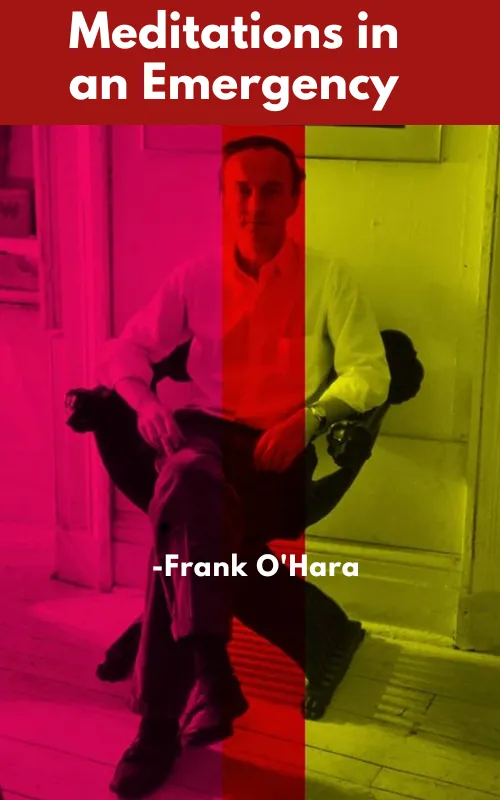About the Poem “Meditations in an Emergency”
| Poem Title | Meditations in an Emergency |
| Author | Frank O’Hara |
| Publication Year | 1957 |
| Literary Movement | Second Generation New York School (New York School of poetry) |
| Style | Free verse, confessional poetry |
| Themes | Love, desire, urban life, politics, and art |
| Setting | New York City during the mid-20th century |
| Structure | Divided into numbered sections or stanzas |
| Famous Lines | “Now I am quietly waiting for the catastrophe of my personality to seem beautiful again, and interesting, and modern.” |
| Influences | O’Hara was influenced by Abstract Expressionism and the works of other poets like Apollinaire and Whitman |
Themes of Meditations in an Emergency
The themes of poem “Meditations in an Emergency” by Frank O’Hara are:
- Love and Desire ➤ The poem reflects on the complexities of love and desire in a modern urban setting.
- Urban Life ➤ It captures the essence of life in New York City during the mid-20th century, with all its energy and chaos.
- Politics ➤ O’Hara touches on political and social issues, particularly the anxieties of the Cold War era.
- Art ➤ The poem integrates art and creativity as a means of coping with the challenges of life in the city.
- Personal Reflection ➤ O’Hara’s personal thoughts and emotions are a central theme, making it a confessional poem.
Meditations in an Emergency Summary & Analysis
Frank O’Hara’s poem “Meditations in an Emergency” is a stream-of-consciousness reflection on love, loss, and the nature of existence. The poem is written in a loose, conversational style, and its speaker is a deeply introspective and self-aware individual.
The poem begins with the speaker meditating on his own physical appearance and personality. He describes his eyes as “vague blue, like the sky, and change all the time.” He is “indiscriminate but fleeting, entirely specific and disloyal, so that no one trusts me.” This suggests that the speaker is a complex and multifaceted individual, whose thoughts and feelings are often difficult to pin down.
The speaker then shifts his focus to his beloved. He is clearly smitten with this person, but he also understands that their relationship is doomed. He bemoans the fact that his heart is “broken” and that it makes him “more adventurous” each time it happens. However, he recognizes that his beloved is not solely to blame for his suffering. He is complicit because he is always looking for new and exciting relationships.
The speaker’s thoughts then turn to his home city of New York. He admires the city’s vitality and energy, but he is also aware of its dark side. He mentions “Chinamen” who “jump” at night, as well as the “subway” that he must be near in order to “enjoy a blade of grass.” This implies that the speaker sees New York as a place of both beauty and danger, of hope and despair.
The poem ends with the speaker declaring, “There’s a lot ahead…. Turning, I spit in the lock and the knob turns.” This suggests that the speaker is ready to move on from their recent loss and embrace the future.
FAQs from Frank O’Hara
What is the meaning of the poem meditations in an emergency?
The meaning of the poem Meditations in an Emergency is a reflection on the speaker’s thoughts and feelings about love, loss, and the human condition.
What is the message to the poem?
The message of the poem is to find hope and beauty in the everyday, even in the face of loss and change.
Who does Don mail meditations in an emergency to?
Don mails Meditations in an Emergency to Anna Draper.











